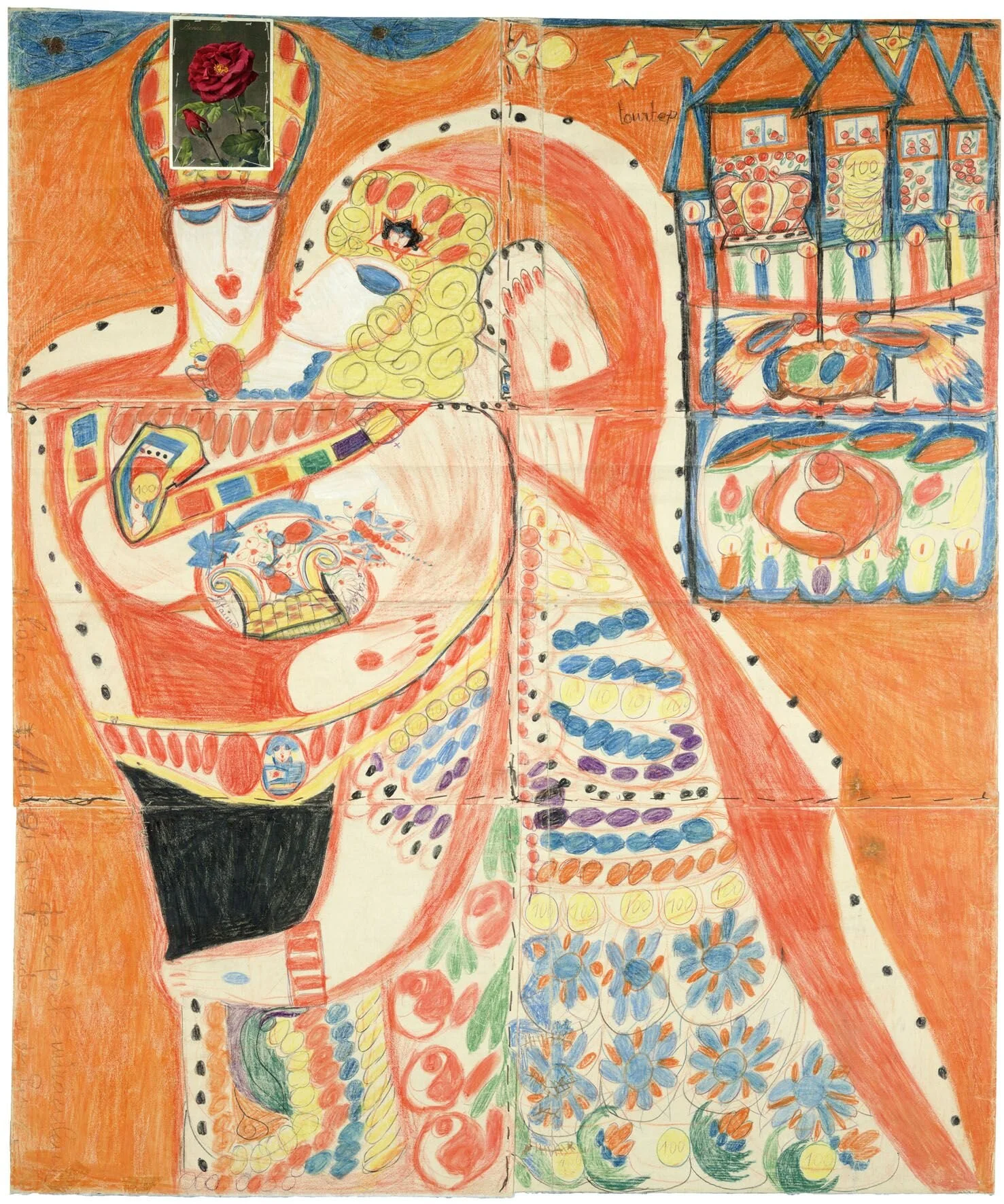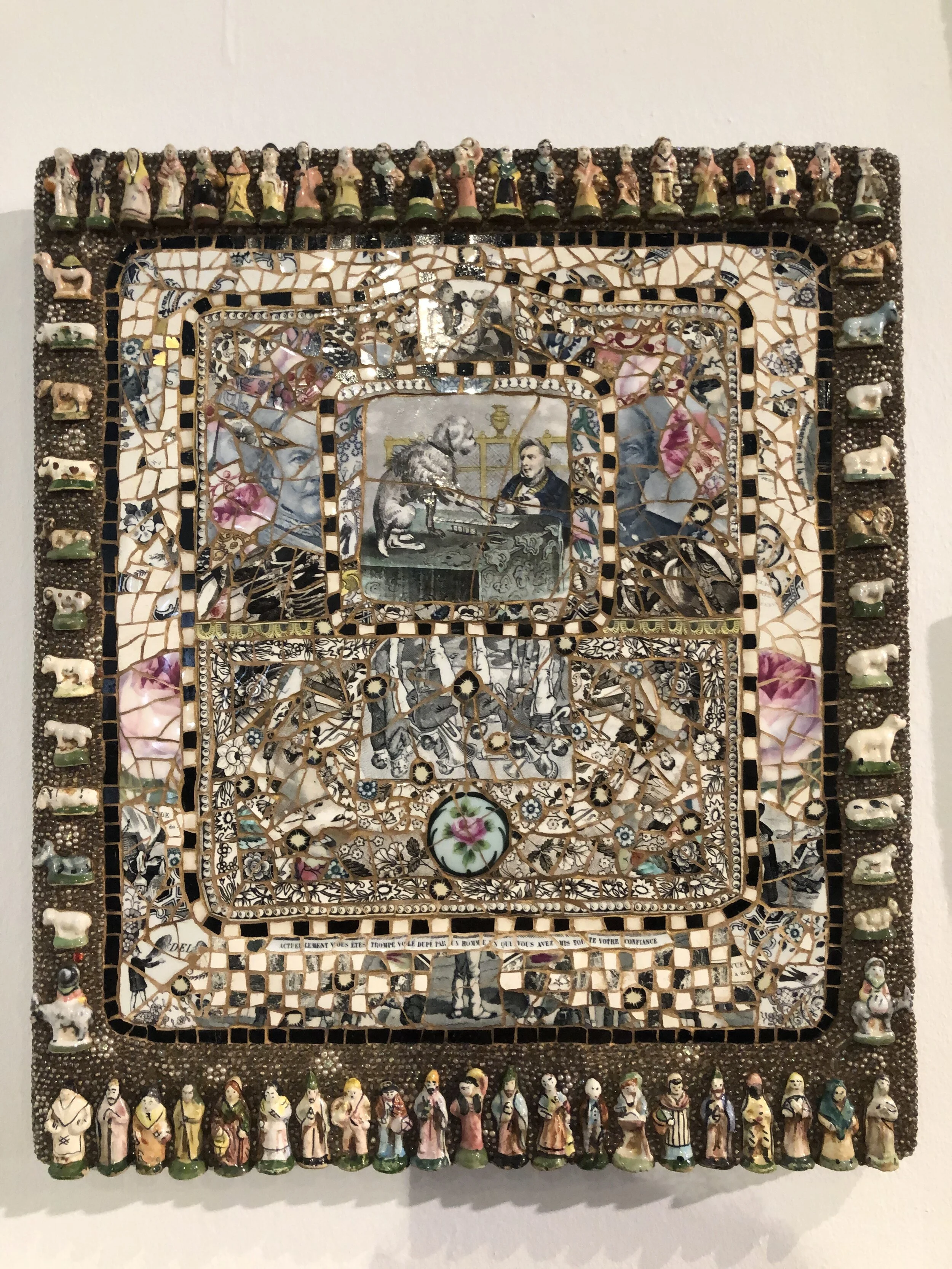Ornamentation
Adolf Wolfli, Rosalie’s heart-shaped crown of thorns, 1922
I do not know if my love for ornamentation and excessive decoration comes from my oriental upbringing, where women (from any social background) always have to present well; nails are always neatly painted, hair always tamed sophisticated and straighten. Surely my wild curly hair must have been and eccentricity.
I always felt that in Lebanon, stepping outside of your home is synonym of parading. Taking your most expensive, flashy or valuable ornament, the same way a peacock would when opening its tail to begin its dance.
Or maybe is it because of my Christian Greek orthodox heritage, recognizable by its very opulent churches, with golden arabesques everywhere, patterns everywhere. Chalices with beautifully inlaid gems, intricately decorated reliquaries etc…
Whichever it is, the ornamental or should I say “decorative” part of my work always intervenes as a way of counterbalancing the abject.
Being fascinated with this idea that the skin is a “beautiful” soft surface that holds everything else (not as beautiful) in place.
I see my ornamentations as that “girly” element. A bit like tying a nice red bow around a pile of crap, or even the way relics are presented; piles of bones or teeth the belong to someone that is now a rotting corpse, placed in the middle of a precious, overly decorated box.
It is with no surprise that I place outsider art at the heart of what I call ornamentation.
Far from thinking that Outsider art is ornamental, or decorative, I made an observation after long and obsessive researches on the subject; a lot of these works have in common their heavy ornamental qualities and repetitive patterns.
I would say that obsessive and repetitive are almost synonym; in the repetition of the gesture, the hand adopting the same position, same pressure on the pen to repeat indefinitely the same shape over and over and over, until turning into obsession.
Maybe it is the fact that patterns are easily accessible drawings, or maybe it is because like in the making of a mandala (that only consists of patterns) there is a certain meditative quality to pattern making. We get lost because the gesture is the same, and the hand almost ends up moving on its own, the muscle having absorbed its designated movement.
What is sure, is that, although easily execute, when made compulsively and in big number, patterns always end up having an impressive quality. They are the things that give the ornamental aspect to a drawing.
Small, intricate, and close to each other, patterns can sometimes look like lace, carvings or precious gems.
Augustin Lesage, A Symbolic Composition of the Spiritual World, 1923
Augustin Lesage, (like many art brut artists) explained that his paintings were guided by spirits who were the ones who encouraged him and even guided him through his artistic process. Placing yourself on the side of those who believe or those who don’t has not much importance, the only thing that everyone could agree on, is the transcendental quality of his work. In his shapes, we can see insectoid shapes as well architectural ones. His works transports us in as many dimensions as there are layers.
Guo Fengyi, spirit drawing
Guo Fengyi was a Chinese outsider artist, her work always fascinated me because it held this very strong spiritual feel, and before ever knowing that she was interested in spirituality and mythology I still always felt that it had some connection with a “higher realm” (like a lot of her fellow “outsider artist”). She used to suffer from arthritis and for this reason had to stop working at a rubber factory. She then retired, and started painting and drawing at home. She also turned to the ancient technique of qi-gong, a combination of philosophy, martial arts, breathing regulation, and meditation—to help cope with her pain.
Aloise Corbaz
Aloise Corbaz also had her ailments, she was diagnosed with schizophrenia and placed in an asylum from 1918 to 1964, the year of her death. Corbaz’s work is ruled by flowers, ornaments, femininity, sexuality and sensuality. She (like a all the outsider artists suffering from a mental illness) had this compulsive and obsessive need (and desire) of exteriorising their pain through the physical act and release of making art. And that is why the number of works is always overwhelming, and each piece so rich. There is an undeniable meditative quality in the gestural act of making pattern; Fengyi and Corbaz are the best example of that.
In July 2019, Les halles saint pierre in Paris (a gallery that showcases outsider art), was giving an exhibition entitled “Chicago, foyer de l’art brut” (Chicago, home for Art brut).
And once again what struck me, was the immediacy of the art I had in front of my eyes.
Immediate not only because of this unstoppable desire to create, that seeps out from all the works’ pores, but also by the (simplicity of) materials that were used. By that I mean, every single random things we could find in our homes. From newspaper and magazine pages, to beer caps, can, but also gadgets and kids’ toys. Exit the pretentiousness of “noble” material. It was a refreshing way of seeing that art
Mr. Imagination, Sun Shield, 1999
It all begins with an idea. Maybe you want to launch a business. Maybe you want to turn a hobby into something more. Or maybe you have a creative project to share with the world. Whatever it is, the way you tell your story online can make all the difference.
One of the most telling examples was an artist I so far had never heard of: Mr. Imagination (Gregory Warmack)
He thought that we were all kings and queens and that everyone should live as such.
The heavy ornamentation in his work is only a proof of this statement.
He would proudly say before anyone would step into his house “It’s like stepping into another world”. This sentence in a way summarizes Mr. Imagination’s approach to art making. He makes me think of a magician that picks up some dirt form the floor and turns into something completely impressive by the power of his imagination.
Inspired by his early life’s imagery (Africa). When we look at African masks, we see that what is used is what is found in the everyday, magnified into a object of beauty. And what he had access to in his everyday life in Chicago were bottle caps, shards of various broken objects, button, random wires. In a word, things that everyone would consider garbage but that he saw as a potential for an art piece. He was able to turn insignificant bottle caps into jewelry-like objects.
Severine Gambier
Niki de Saint Phalle, The Garden of Tarot, 1979-1993
I noticed that a lot of outsider artist would have this desire of expanding their art to their living space itself. Architecture is usually something that is thought to be something that has a practical outcome. It is often straightforward, clean and “contained”. But around the world exits some sites where the architecture feels like a growing being, or as if art has been invading the home, not only inside but on the face, influencing the shape itself into odd unusual shapes.
Niki de St Phalle’s Tarot Garden is maybe of the only sites I can think off that takes this form but that is not considered outsider. And here again what strikes us is that ornamental quality. Colourful mosaic covers every singe inch of the place and even the interior. It is not scene like a home anymore, but more like a gigantic work of art in which one could technically live.
The theme is mystical, the tarot and it only makes sense that the work en up taking an extravagant, flashy and heavily decorated style.
No spiritual (or religious) subject was ever approached with a minimalistic, simplistic way. The decorative process is long and intricate and gives justice to its theme.
Jacques Lucas, La maison sculptée, under construction since 1968








